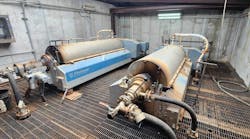Introduction
On July 1, 2014, California became the first state in the nation to mandate an MCL of 10 ppb for hexavalent chromium (chromium-6). The MCL of 10 ppb as chromium-6 requires quarterly compliance monitoring at individual water sources or entry points to the distribution system after treatment. Compliance with the MCL is to be determined by a running annual average of quarterly samples. Water utilities must begin compliance sampling by the end of 2014.
Starting in 2012, Soquel Creek Water District (District) in Santa Cruz County and a consulting firm in collaboration with the Water Research Foundation, began implementing a small-scale bench and field pilot study to find an optimum treatment for chromium-6. Approximately one-third of the District’s water supply is impacted by naturally occurring chromium-6. The District already treats for iron and manganese, as well as arsenic, in other well supplies.
The imperatives were to find a reliable, proven technology and minimize capital and O&M costs. Criteria included: A system that’s easy to deploy, utilizes a standard, approved ion exchange resin, with components that are NSF 61 certified and a demonstrated capability to remove chromium-6. Also, a technology that produced the smallest possible waste volume for disposal was considered especially critical.
For the full-scale demonstration study, the District selected a strong-base anion exchange technology. While the treatment method is new to the District, the system was chosen for its modular design, as well as its cutting-edge brine treatment process that showed promise as an efficient method to handle the waste generated. It is expected that such advantages would improve the treatment economics. The company chosen mobilized quickly with a full-service plan to meet the District’s demanding demonstration specifications.
The District will shortly deploy the system as a temporary full-scale (1,000 gpm) facility until a permanent facility can be evaluated under the California Environmental Quality Act (CEQA), as well as design, permits and construction — a process that is expected to take approximately two years.
Installation and progress
The 1,000 gpm demonstration system was designed, built and connected over a six-month period. This streamlined installation was enabled by the system’s modular, plug-and-play configuration that requires just a simple inlet/outlet connection, along with a power connection.
The installation process included construction of a half-mile of raw water main and on-site utility modifications. Although the District’s chromium-6 impacted wells are geographically dispersed, construction of a centralized strong-base anion exchange treatment facility rated at 2,000 gpm is planned to treat any two of three wells in the vicinity. Approximately one mile of raw waterline is required to convey untreated water to the centralized treatment facility. A fourth chromium-6 impacted well located in a separate pressure zone will be placed on standby status with the State Water Resources Control Board’s (SWRCB) Division of Drinking Water (DDW); an intertie between the two pressure zones is planned to supplement the lost production.
Outcome and results
Through bench and pilot studies conducted in collaboration with the selected consulting firm and technology company, the District demonstrated that the strong-base anion exchange treatment process is by far the most suitable technology to use given its water quality. Not only did the pilot testing capably reduce chromium-6 levels and produce water that exceeds the requirements of the DDW, but the equipment also provided confirmation for the chromium treatment capacity of the plant and demonstrated the feasibility of brine reuse and waste volume minimization and treatment.
In particular, the technology showcased these advantages during the pilot study:
- First, the study showed that it was feasible to remove the chromium-6 from the water to a treatment objective of 8 ppb with greater than 99.99 percent water efficiency.
- Second, the small-system footprint exceeded expectations. This is important because available vacant land within the District is limited. Other possible treatment processes require implementing larger footprints or large volumes of additional chemicals. The modular configuration also allows for flexibility and quick deployment. The 1,000 gpm system including associated brine treatment tanks occupies just under 800 sq. ft. of space.
Over the next six months, the District will continue to work with the chosen company to optimize the brine treatment technology —important activities that will inform the design of a full-scale permanent treatment facility.
Finally, in part due to the successful pilot, the District’s Board decided to set a treatment goal of 2 ppb where treatment is applied, and directed implementation of one full-scale 2,000 gpm treatment facility at the District’s Bonita Well Site.
To this end, the District will begin drafting the procurement documents over the next three months. The bid period starts early in 2015 and the contract for equipment procurement will be awarded in April 2015.
Taj Dufour started his water career with the District’s engineering department in 2000. For two years, Dufour managed the Operations & Maintenance Department and in 2010, returned to the Engineering Department as the engineering manager/chief engineer. He holds a bachelor’s degree in Mechanical Engineering from Cal Poly in San Luis Obispo, and is a registered civil engineer in the State of California. He holds a grade D-4 Water Distribution certificate and a grade T-3 Water Treatment certificate issued by the State Water Resources Control Board, Drinking Water Program. Before coming to the District, Dufour worked at General Electric Nuclear Energy in San Jose between 1995-2000, where he traveled to Japan and designed tools that serviced the nuclear energy industry.
Mike Waite developed water decontamination and waste minimisation technologies for the U.K. nuclear industry before starting Ionex SG in 2001. Ionex became part of the Severn Glocon Group in 2011 and Mike, now technical director, is responsible for research and new product development for near-zero waste drinking water treatment.
Dr. Chad Seidel, Ph.D., P.E., is vice president at Corona Environmental Consulting LLC. He has been engaged with water utilities regarding chromium in drinking water since 2000, when California utilities started to respond to public concerns raised by the Erin Brockovich movie. Since then, he has worked with utilities throughout California and across the U.S. to understand chromium occurrence and treatment methods.
Craig Gorman, P.E., is a water process engineer at Corona Environmental Consulting LLC. He has lead chromium-related technology selections, bench- and pilot-scale evaluations, cost estimating and design efforts for drinking water utilities


